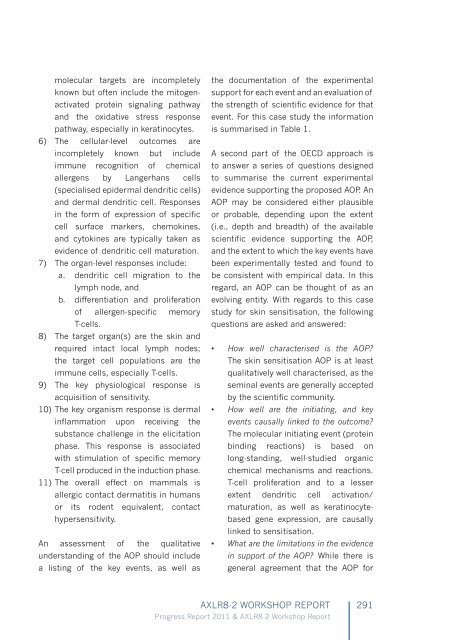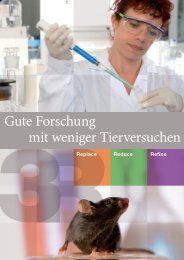You also want an ePaper? Increase the reach of your titles
YUMPU automatically turns print PDFs into web optimized ePapers that Google loves.
molecular targets are incompletely<br />
known but often include the mitogenactivated<br />
protein signaling pathway<br />
and the oxidative stress response<br />
pathway, especially in keratinocytes.<br />
6) The cellular-level outcomes are<br />
incompletely known but include<br />
immune recognition of chemical<br />
allergens by Langerhans cells<br />
(specialised epidermal dendritic cells)<br />
and dermal dendritic cell. Responses<br />
in the form of expression of specific<br />
cell surface markers, chemokines,<br />
and cytokines are typically taken as<br />
evidence of dendritic cell maturation.<br />
7) The organ-level responses include:<br />
a. dendritic cell migration to the<br />
lymph node, and<br />
b. differentiation and proliferation<br />
of allergen-specific memory<br />
T-cells.<br />
8) The target organ(s) are the skin and<br />
required intact local lymph nodes;<br />
the target cell populations are the<br />
immune cells, especially T-cells.<br />
9) The key physiological response is<br />
acquisition of sensitivity.<br />
10) The key organism response is dermal<br />
inflammation upon receiving the<br />
substance challenge in the elicitation<br />
phase. This response is associated<br />
with stimulation of specific memory<br />
T-cell produced in the induction phase.<br />
11) The overall effect on mammals is<br />
allergic contact dermatitis in humans<br />
or its rodent equivalent, contact<br />
hypersensitivity.<br />
An assessment of the qualitative<br />
understanding of the AOP should include<br />
a listing of the key events, as well as<br />
the documentation of the experimental<br />
support for each event and an evaluation of<br />
the strength of scientific evidence for that<br />
event. For this case study the information<br />
is summarised in Table 1.<br />
A second part of the OECD approach is<br />
to answer a series of questions designed<br />
to summarise the current experimental<br />
evidence supporting the proposed AOP. An<br />
AOP may be considered either plausible<br />
or probable, depending upon the extent<br />
(i.e., depth and breadth) of the available<br />
scientific evidence supporting the AOP,<br />
and the extent to which the key events have<br />
been experimentally tested and found to<br />
be consistent with empirical data. In this<br />
regard, an AOP can be thought of as an<br />
evolving entity. With regards to this case<br />
study for skin sensitisation, the following<br />
questions are asked and answered:<br />
• How well characterised is the AOP<br />
The skin sensitisation AOP is at least<br />
qualitatively well characterised, as the<br />
seminal events are generally accepted<br />
by the scientific community.<br />
• How well are the initiating, and key<br />
events causally linked to the outcome<br />
The molecular initiating event (protein<br />
binding reactions) is based on<br />
long-standing, well-studied organic<br />
chemical mechanisms and reactions.<br />
T-cell proliferation and to a lesser<br />
extent dendritic cell activation/<br />
maturation, as well as keratinocytebased<br />
gene expression, are causally<br />
linked to sensitisation.<br />
• What are the limitations in the evidence<br />
in support of the AOP While there is<br />
general agreement that the AOP for<br />
AXLR8-2 WORKSHOP REPORT<br />
Progress Report 2011 & AXLR8-2 Workshop Report<br />
291




